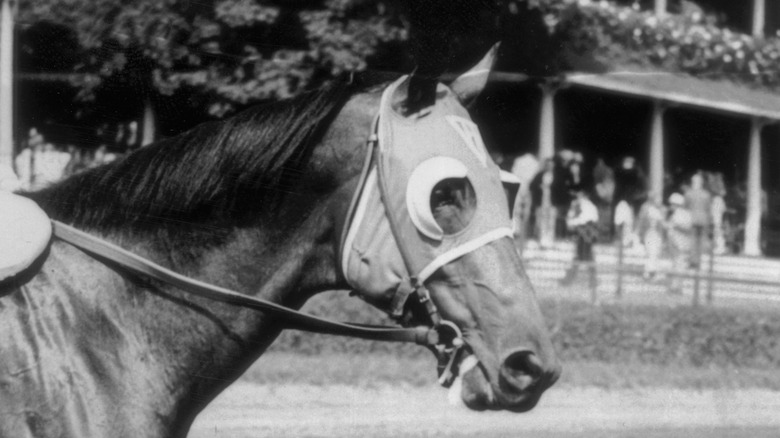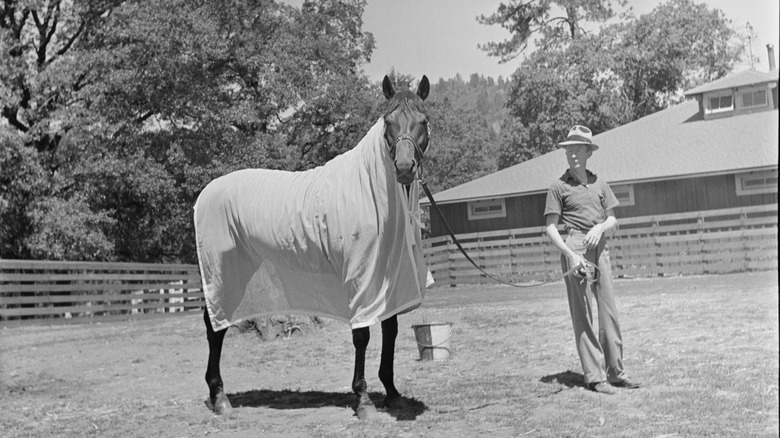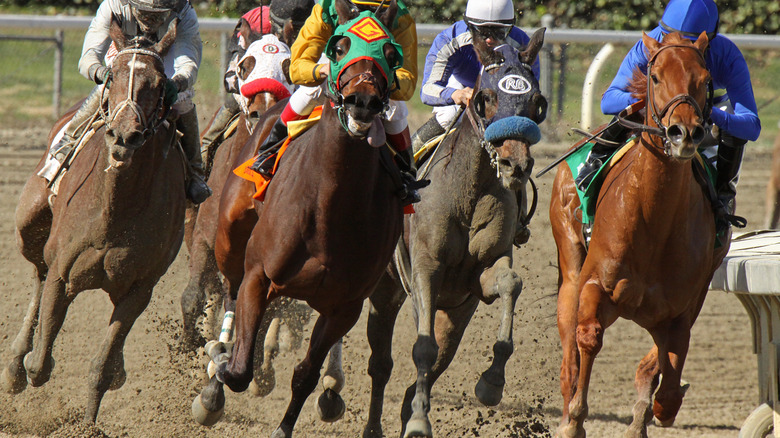This Is Where Seabiscuit Is Buried
Horse racing today is a sport mired in controversy over the drugging of horses and the slaughterhouses where most of them end up. In the era of Seabiscuit, a storied racehorse who set a record for American thoroughbreds during the Depression, per Britannica, there wasn't the same panoply of drugs. But horses whose owners tired of them were still entered in claiming races, as Seabiscuit himself once was.
A claiming race is a way of calibrating the monetary values attached to horses with their performance in races, according to Horse Racing Sense. In a claiming race, each of the horses running is up for sale, and people bid on the horses based on how fast they run. Seabiscuit had an unusual gait, per PBS, with some even dubbing his running style an "eggbeater gait." He was also smaller than Man O' War, his grandfather and a prize-winning stallion.
Because of that and because he was initially difficult to tame, Seabiscuit had humble beginnings and wound up in a claiming race where nobody claimed him, per Britannica. But he had the raw materials of greatness: Scientists who drilled into a preserved hoof after Seabiscuit's death found gene variants that often go along with strong long-distance running abilities, and coupled with this, gene variants usually found in good sprinting horses, the scientists wrote for The Conversation. The scientists also found that horses with this rare genotype are typically "late bloomers," as Seabiscuit proved to be.
Seabiscuit triumphed over War Admiral
Discarded by his first owners after his unpromising early races, Seabiscuit was eventually bought by the millionaire Charles Howard and his trainer, Tom Smith, who were in the stands at that claiming race in Saratoga, New York in 1936, according to Horsey Hooves. By 1937, Seabiscuit was winning race after race. He continued winning right up until his famous race against War Admiral in 1938, which he won, and Howard and Smith kept pushing him until he inevitably suffered a serious injury and had to be retired, per Britannica.
Seabiscuit went to Howard's ranch in Mendocino County, California, where Howard put him out to stud. He sired 108 foals in total during his final years, per Riding Hall. Two of his offspring, Sea Sovereign and Sea Swallow, grew up to win prizes as racehorses.
That ranch, Ridgewood Ranch, is now owned by the Golden Rule Church Association, according to the ranch's website. The association has left Howard's family home intact, and Seabiscuit's stud barn remains in place, too. The ranch currently serves as a historical trove of Seabiscuit memorabilia as well as the site of a 20-acre redwood forest.
Seabiscuit's resting place is a peaceful spot
Seabiscuit died in May 1947, just six days before his 14th birthday, according to Horsey Hooves — but not before he was brought out of retirement in 1940 to race again. This time it was the Santa Anita, per Britannica, a race which he had lost before and which his owners weren't content to leave unconquered. Seabiscuit won that final race.
After his death, Seabiscuit was buried at a Ridgewood Ranch burial site, according to Find a Grave. The nearby Mendocino County Museum now features Seabiscuit mementos and historical trinkets for visitors to peruse.
The exact location of Seabiscuit's grave remains a Howard family secret, per Seabiscuit Heritage. A tree shades the grave all these years later, and that stretch of grass is reportedly protected from development. And while the ranch's original Seabiscuit statue has since made its way to the National Museum of Racing Hall of Fame in New York, a replica now sits at Ridgewood as a memorial to the famous racehorse, who offered up an underdog story for the masses at a time when millions of Americans wanted to cheer for one.


